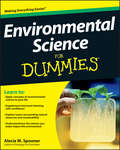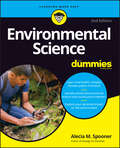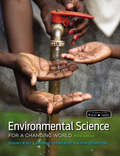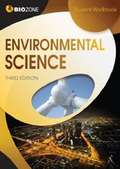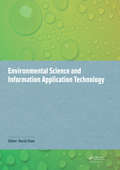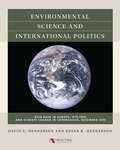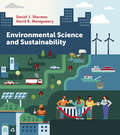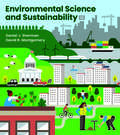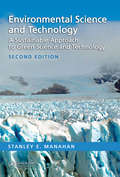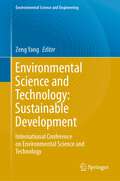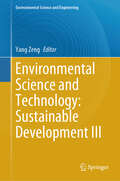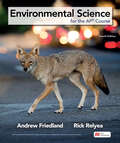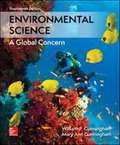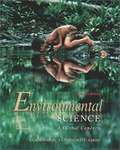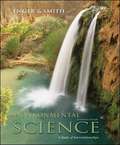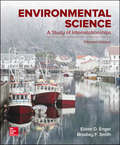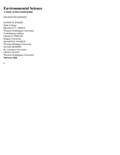- Table View
- List View
Environmental Science 13th ed
by G. Tyler Miller Scott E. SpoolmanENVIRONMENTAL SCIENCE will inspire and equip you to make a difference for the world. Featuring sustainability as their central theme, authors Tyler Miller and Scott Spoolman emphasize natural capital, natural capital degradation, solutions, trade-offs, and the importance of individuals. As a result, you will learn how nature works, how you interact with it, and how people have sustained'and can continue to sustain'our relationship with the earth by applying nature's lessons to economies and individual lifestyles. Engaging features like "Core Case Studies," "How Would You Vote" questions, and "Thinking About" exercises demonstrate the relevance of issues and encourage critical thinking. This edition has been updated with new learning tools, the latest content, and an enhanced art program.
Environmental Science A Global Concern
by William P. Cunningham Mary Ann Cunningham Barbara Woodworth SaigoColor photos and diagrams illustrate this text for undergraduate students with little or no science background. Material is divided into five sections on environmental science and ecological principles; population, economics, and environmental health; food, land, and biological resources; physical resources; and society and the environment, emphasizing the global environment, a holistic approach, and sustainable development. This third edition contains new boxes on current topics including electromagnetic fields and biotechnology. Annotation c. by Book News, Inc. , Portland, Or.
Environmental Science For AP®
by Andrew Friedland Rick RelyeaEnvironmental Science For AP® Textbook
Environmental Science For Dummies
by Alecia M. SpoonerThe easy way to score high in Environmental ScienceEnvironmental science is a fascinating subject, but some students have a hard time grasping the interrelationships of the natural world and the role that humans play within the environment. Presented in a straightforward format, Environmental Science For Dummies gives you plain-English, easy-to-understand explanations of the concepts and material you'll encounter in your introductory-level course.Here, you get discussions of the earth's natural resources and the problems that arise when resources like air, water, and soil are contaminated by manmade pollutants. Sustainability is also examined, including the latest advancements in recycling and energy production technology. Environmental Science For Dummies is the most accessible book on the market for anyone who needs to get a handle on the topic, whether you're looking to supplement classroom learning or simply interested in learning more about our environment and the problems we face.Presents straightforward information on complex conceptsTracks to a typical introductory level Environmental Science courseServes as an excellent supplement to classroom learningIf you're enrolled in an introductory Environmental Science course or studying for the AP Environmental Science exam, this hands-on, friendly guide has you covered.
Environmental Science For Dummies
by Alecia M. SpoonerAce your environmental science class and get smart about the environment Environmental Science For Dummies is a straightforward guide to the interrelationships of the natural world and the role that humans play in the environment. This book tracks to a typical introductory environmental science curriculum at the college level—and is great as a supplement or study guide for AP Environmental Science, too. Uncover fascinating facts about the earth’s natural resources and the problems that arise when resources like air, water, and soil are contaminated by pollutants. If you’re in need of extra help for a class, considering a career in environmental science, or simply care about our planet and want to learn more about helping the environment, this friendly Dummies resource is a great place to start. The key concepts of environmental science, clearly explained All about the changing climate, including new understanding of methane release in the arctic Earth’s natural resources and the importance of protecting them A new chapter on environmental justice, where issues of poverty and sustainability intersectA solid foundation in environmental science is essential for anyone looking for a career in the field—and is important knowledge for all of us as we work together to build a sustainable future.
Environmental Science For a Changing World (Third Edition)
by Anne Houtman Susan Karr Jeneen Interlandi<P>Following real people and real science, Environmental Science for a Changing World provides a unique context for showing students how science works and how to think critically about environmental issues. Chapters don’t merely include interesting stories they are examples of science journalism at its best, combining Scientific American-style writing, layout, and graphics to tell compelling stories that exemplify important concepts and issues. This approach has proven so effective that instructors using the book report a dramatic increase in the number of students who read the assignments and come to class ready to participate. <P>This updated new edition features new stories, updated scientific coverage, and enhanced Infographics—the book’s signature visual study tool that combines memorable images, step-by-step callouts, and questions that foster scientific literacy. The book is organized into 11 chapters, each consisting of multiple modules focused on different aspects of environmental science, from ecology and evolution, to human interactions with the environment, to land, water, and energy resources. Although each module tells a compelling and relatable story, it is built on a core pedagogy of Guiding Questions that help students extract the scientific concepts that form the basis for the story.
Environmental Science Student Workbook (Third Edition)
by Tracey Greenwood Richard Allan Kent Pryor Lisa Bainbridge-SmithEnvironmental Science introduces students to the Earth's physical and biological systems, and the interactions of humans with these. This revision introduces new content and aligns the workbook to its supporting digital resources. Content developments include updates on the Gulf of Mexico oil spill and the Fukushima Daiichi nuclear disaster, and in-depth coverage of energy extraction issues, pollution, and the wider environmental implications of urban development. The ideal companion to both the APES curriculum and the IB Environmental Systems and Societies.
Environmental Science and Information Application Technology: Proceedings of the 2014 5th International Conference on Environmental Science and Information Application Technology (ESIAT 2014), Hong Kong, November 7-8, 2014
by David ChanEnvironmental Science and Information Application Technology contains selected papers from the 2014 5th International Conference on Environmental Science and Information Application Technology (ESIAT 2014, Hong Kong, 7-8 November 2014). The book covers a wide variety of topics: - Global Environmental Change and Ecosystems Management - Graphic and I
Environmental Science and International Politics: Acid Rain in Europe, 1979-1989, and Climate Change in Copenhagen, 2009
by David E. Henderson Susan K. HendersonEnvironmental Science and International Politics features two reacting games in one volume, immersing students in the complex process of negotiating international treaties to control environmental pollution. The issues are similar in all the modules; environmental justice, national sovereignty, and the inherent uncertainty of the costs and benefits of pollution control. Students also must understand the basic science of each problem and possible solutions. Acid Rain in Europe, 19779-1989 covers the negotiation of the Long Range Transport Pollution treaty. This was the first ever international pollution control treaty and remains at the forefront of addressing European pollution. This game can be used in a variety of ways and to examine either sulfur dioxide pollution, nitrogen oxide pollution, or both. This game includes summaries of a number of relevant technical articles to support student arguments. Students must deal with the limitations of national resources as they decide how much of their limited money to spend.Climate Change in Copenhagen, 2009 covers the negotiations at the Conference of Parties 15 meeting that was attended by a large number of national leaders. The game also includes representatives of non-government organizations and the press. Students wrestle with the need to work within conflicting limits set by their governments.
Environmental Science and Sustainability
by David R. Montgomery Daniel J. ShermanMake environmental science and sustainability personal Environmental Science and Sustainability helps students discover their role in the environment and the impact of their choices. Authors David Montgomery and Daniel Sherman bring scientific and environmental policy expertise to a modern treatment of environmental science; in addition to teaching climate change, sustainability, and resilience, they reveal how our personal decisions affect our planet and our lives. This purchase offers access to the digital ebook only.
Environmental Science and Sustainability (Second Edition)
by David R. Montgomery Daniel J. ShermanMake environmental science personal More than ever, students are thinking about their choices in a changing environment. Environmental Science and Sustainability gives students a scientific understanding of the environment while helping them practice decision-making. The Second Edition now integrates the role environmental justice plays in decisions, and new insights gained from the pandemic and IPCC Sixth Assessment. The Norton Illumine Ebook, InQuizitive, and What Would You Do? decision-making activities build a learning pathway of interactive reading and practice at one low price. This purchase offers access to the digital ebook only.
Environmental Science and Technology
by Lllionois DanvilleA natural resource is a naturally occurring material or organism that supports life, provides fuel, or is used in other ways by humans. We cannot make natural resources, but we certainly use them in many ways. Some natural resources are essential for living, such as oxygen and water; other natural resources are used in manufacturing other items, such as iron into automobiles. The wise use of resources is important. For example, cropland, grassland, woodland, and other land types must be used properly. Keeping our land productive is a major challenge. Productive land ensures healthy people and a strong nation.
Environmental Science and Technology: A Sustainable Approach to Green Science and Technology, Second Edition
by Stanley E. ManahanFormally established by the EPA nearly 15 years ago, the concept of green chemistry is beginning to come of age. Although several books cover green chemistry and chemical engineering, none of them transfer green principles to science and technology in general and their impact on the future. Defining industrial ecology, Environmental Science and Tec
Environmental Science and Technology: International Conference on Environmental Science and Technology (Environmental Science and Engineering)
by Zeng YangThis book features a collection of high-quality and peer-reviewed papers from 2022 13th International Conference on Environmental Science and Technology, which was held in Shandong, China, during October 21–23, 2022. ICEST is held annually as a platform for presentation of new advances and research results in the fields of Environmental Science and Technology. This year, we focus on the theme: Environmental Protection and Sustainable Development. With the continuous development of human society, environmental problems are becoming more and more serious. How to realize the rational use of resources, realize the sustainable development of ecological environment, and protect the environment on which human beings live has become an urgent problem to be solved. Based on the conference theme this year, the presentations include the topical areas of environmental sustainability, environmental restoration, waste minimization, solid waste management, water pollution control, water treatment and reclamation, air pollution control, carbon capture and storage and environmental monitoring, etc.
Environmental Science and Technology: Sustainable Development III (Environmental Science and Engineering)
by Yang ZengThis book features a collection of high-quality and peer-reviewed papers from 2024 15th International Conference on Environmental Science and Technology, which was held in Xiamen, China, during November 21-23, 2024. These proceedings serve as a valuable record of the latest scientific advancements, methodologies, and discussions in various environmental disciplines. Key topics typically covered include environmental chemistry, engineering, biology, health, management and policy, climate change, sustainable development, renewable energy, water and soil management, toxicology, and waste management. The proceedings facilitate knowledge exchange among scientists, engineers, policymakers, and other stakeholders, promoting interdisciplinary collaboration and the development of innovative solutions to global environmental challenges.
Environmental Science for AP®
by Andrew Friedland Rick RelyeaEnvironmental Science for the AP® Course was built from the ground up specifically to suit the needs of AP® environmental science teachers and students. Friedland/Relyea integrates AP® content and exam prep into a comprehensive college-level textbook, providing students and teachers with the resources they need to be successful in AP® Environmental Science. Features throughout the textbook include AP® Exam Tips, math tutorials and review, review questions, and complete AP® Practice Exams. Strong media offerings include online homework to provide just-in-time feedback, as well as adaptive quizzing. Environmental Science for the AP® course provides students with the support they need to be successful on the AP® Environmental Science exam and in the college classroom.
Environmental Science for the AP® Course
by Andrew Friedland Rick RelyeaFriedland/Relyea helps students gain the knowledge and skills needed to succeed on the AP® exam.
Environmental Science: A Global Concern
by William P. Cunningham Mary Ann CunninghamColor photos and diagrams illustrate this text for undergraduate students with little or no science background. Material is divided into five sections on environmental science and ecological principles; population, economics, and environmental health; food, land, and biological resources; physical resources; and society and the environment, emphasizing the global environment, a holistic approach, and sustainable development. This third edition contains new boxes on current topics including electromagnetic fields and biotechnology.
Environmental Science: A Global Concern
by William P. Cunningham Mary Ann CunninghamFor undergraduate students with little or no science background. Material is divided into five sections on environmental science and ecological principles; population, economics, and environmental health; food, land, and biological resources; physical resources; and society and the environment, emphasizing the global environment, a holistic approach, and sustainable development. This third edition contains new boxes on current topics including electromagnetic fields and biotechnology. Annotation c. by Book News, Inc. , Portland, Or.
Environmental Science: A Global Concern
by William P. Cunningham Mary Ann CunninghamEnvironmental Science: A Global Concern is a comprehensive presentation of environmental science for non-science majors which emphasizes critical thinking, environmental responsibility, and global awareness. This book is intended for use in a one or two-semester course in environmental science, human ecology, or environmental studies at the college or advanced placement high school level. As practicing scientists and educators, the Cunningham author team brings decades of experience in the classroom, in the practice of science, and in civic engagement. <P><P>This experience helps give students a clear sense of what environmental science is and why it matters in this exciting, new 14th edition. <P><P>Environmental Science: A Global Concern provides readers with an up-to-date, introductory global view of essential themes in environmental science. The authors balance evidence of serious environmental challenges with ideas about what we can do to overcome them. An entire chapter focuses on ecological restoration; one of the most important aspects of ecology today. Case studies in most chapters show examples of real progress, and “What Can You Do?” lists give students ideas for contributing to solutions.
Environmental Science: A Global Concern
by William P. CunninghamThis book is intended for use in a one- or two-semester course in environmental science, human ecology, or environmental studies at the college or advanced placement high school level. Because most students who will use this book are freshman or sophomore nonscience majors, the authors have tried to make the text readable and accessible without technical jargon or a presumption of prior science background. At the same time, enough data and depth are presented to make this book suitable for many upper-division classes and a valuable resource for students who will keep it in their personal libraries after their formal studies are completed. The goal of this book is to provide an up-to-date, introductory view of essential themes in environmental science along with emphasis on details and case studies that will help students process and retain the general principles.
Environmental Science: A Study Of Interrelationships (A/P Environmental Science Ser.)
by Bradley F. Smith Eldon D. EngerNIMAC-sourced textbook
Environmental Science: A Study of Interrelationships
by Bradley F. Smith Eldon D. EngerThis full-color, introductory environmental science text is known for being concise, conceptual, and value-priced. The approach and reading level cover the basic concepts without overloading students with too much detail. The authors reinforce the text's central theme of "interrelationships" by providing a historical perspective, information on economic and political realities, discuss the role of different social experiences, and integrate this with the crucial science to describe the natural world and how we affect it.
Environmental Science: A Study of Interrelationships
by Bradley F. Smith Eldon D. EngerThis environmental science text is known for being concise, conceptual, and value-priced. The approach and reading level cover the basic concepts without overloading students with too much detail. The authors reinforce the text's central theme of "interrelationships" by providing a historical perspective, information on economic and political realities, discuss the role of different social experiences, and integrate this with the crucial science to describe the natural world and how we affect it.
Environmental Science: A Study of Interrelationships
by Bradley F. Smith Eldon D. EngerEnvironmental Science: A Study of Interrelationships is a full-color, introductory environmental science text that is known for being concise, conceptual, and value-priced. The approach and reading level cover the basic concepts without overloading students with too much detail. <p><p>The authors reinforce the text's central theme of "interrelationships" by providing a historical perspective, information on economic and political realities, discuss the role of different social experiences, and integrate this with the crucial science to describe the natural world and how we affect it.



